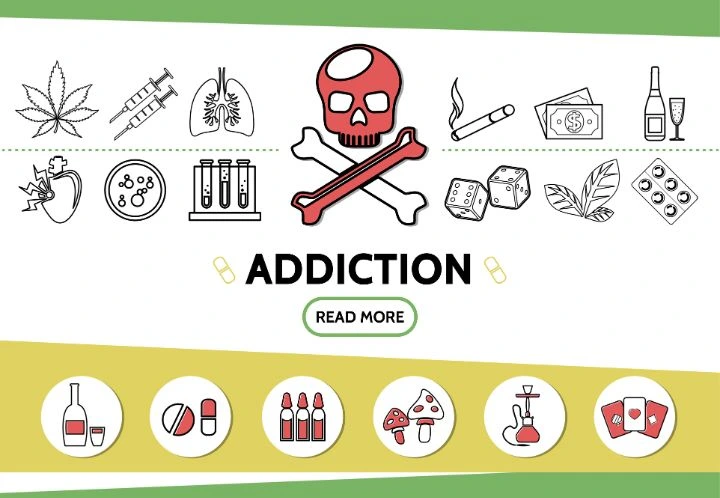In 2023, a survey revealed that approximately 48.5 million US citizens struggled with substance use. Drug addiction is a pressing issue that is more than just personal struggles. It leaves an unperishable scar on families, communities, and economies.
It affects individuals physically, mentally, and emotionally, while society bears the burden of its far-reaching consequences. This blog explores the negative impacts of drug addiction and provides actionable ways to support those on their recovery journey.
By understanding the challenges and opportunities for recovery, we can foster a compassionate and supportive environment that paves the way towards healing.
How Drug Addiction Harms Individuals, Society, and Finances
1. Impact on Individuals
Physical Health
Drug addiction takes a severe toll on physical health. Prolonged substance abuse can lead to chronic illnesses such as:
- Liver damage
- Cardiovascular diseases
- Neurological disorders.
Overdose risks remain a constant threat, with many losing their lives to substances that overpower the body’s tolerance. Almost 97,000 people lose their lives to drug overdose annually.
For instance, opioid addiction often results in respiratory failure, while stimulants like methamphetamine can cause irreversible heart and brain damage.
Mental Health
Addiction often coexists with mental health disorders like depression, anxiety, and bipolar disorder. This also holds true in reverse. The chemical changes caused by substance abuse disrupt brain function, intensifying feelings of hopelessness and despair.
Individuals struggling with addiction often fall into the vicious cycle of self-medication, where they use substances to escape mental health challenges, only to exacerbate them in the long run. The stigma surrounding both addiction and mental health frequently prevents individuals from seeking help, deepening their isolation.
Relationships
Source: Freepik
Along with health issues, drug addiction can adversely affect your relationships. Drug addiction can lead to an unstable family life and reduction in the sense of belonging. Loved ones may feel helpless or resentful, leading to strained bonds and isolation for the person struggling with addiction.
Children in these environments often experience neglect or trauma, which can have lasting psychological effects. Family members may also develop enabling behaviors that unintentionally prolong the cycle of addiction.
2. Impact on Society
 Source: Freepik
Source: Freepik
Increased Crime Rates: Addiction contributes to rising crime rates, as individuals may resort to theft, violence, or other illegal activities to sustain their habits. Drugs have also been responsible for many gang wars throughout history.
The drug trade fosters organized crime and societal instability, with cartels and traffickers creating an atmosphere of fear and lawlessness. In 2021 alone, over 1.2 million drug-related arrests were made in the U.S., straining law enforcement resources.
Healthcare System Overload: Around $11 billion is spent on healthcare costs related to substance abuse. The demand for addiction treatment, emergency care for overdoses, and long-term health interventions places immense pressure on healthcare systems. In regions grappling with an addiction crisis, emergency departments are often overwhelmed, diverting resources from other critical healthcare needs.
Generational Trauma: The effects of addiction ripple through generations. Children of addicts are more likely to develop substance use disorders themselves, either due to genetic predisposition or environmental factors. High school and college students who are addicted to drugs often face challenges like:
- Lack of concentration
- Bad attendance
- Negative effects on grades
These children often face educational setbacks and emotional instability, perpetuating cycles of poverty and addiction.
3. Economic Consequences
 Source: Freepik
Source: Freepik
Individual Financial Struggles
Addiction often leads to job loss and mounting debts as individuals prioritize substances over financial stability. Families bear the brunt of these financial hardships, sometimes losing homes, savings, or opportunities for education. A recovering addict’s journey to rebuild financial security can take years, further stressing familial resources.
Community and National Costs
Governments face substantial expenses for law enforcement, healthcare, and rehabilitation programs. For instance, the opioid crisis has cost the U.S. economy over $1.5 trillion in healthcare costs, lost productivity, and criminal justice expenditures.
Workplace Productivity
Employers report higher rates of absenteeism, decreased efficiency, and workplace accidents linked to substance use. Industries that rely on manual labor or critical decision-making, such as construction or transportation, are particularly affected by addiction-related challenges.
Part 2: How to Support Individuals on Their Recovery Journey
Understanding Addiction
Remember, addiction is a chronic disease, not a moral failing. It alters brain chemistry, creating dependency and compulsive behaviors. Recognizing addiction as a medical condition is the first step in reducing stigma and encouraging those affected to seek help. Studies show that individuals who feel supported and understood are more likely to pursue and stick with a recovery program.
2. Steps to Recovery
If you are an addict, here’s how you can start your journey to recovery:
- Seek Professional Help
- Community Support
- Holistic Therapies
Let’s have a look at all of these in detail:
Seek Professional Help
Treatment options include detoxification programs, cognitive-behavioral therapy (CBT), and medication-assisted treatments that address both physical dependency and psychological challenges.
Medications like methadone or buprenorphine can help individuals manage withdrawal symptoms and reduce cravings. Residential rehabilitation programs often combine medical and psychological treatments for a comprehensive approach.
Community Support
Peer support groups like Narcotics Anonymous (NA) and Alcoholics Anonymous (AA) provide a safe space to share experiences and receive encouragement. Online platforms now offer virtual support for individuals unable to attend in person. Studies indicate that participation in these groups significantly reduces the risk of relapse.
Holistic Therapies
Complementary approaches such as mindfulness meditation, yoga, and regular exercise help individuals manage stress and rebuild their physical and emotional well-being. Nutrition therapy, for instance, focuses on replenishing nutrients depleted by substance abuse, aiding both recovery and mental clarity.
3. Creating a Supportive Environment
Role of Family and Friends
Families play a critical role in recovery. By listening without judgment, setting boundaries, and offering encouragement, loved ones can create a foundation of trust and hope. Family therapy can help address underlying issues and improve communication, fostering a healthier dynamic that supports recovery.
Workplace and School Policies
Institutions can support recovery by implementing flexible schedules, providing counseling services, and educating peers about addiction’s challenges. Employee Assistance Programs (EAPs) often connect employees to valuable resources like therapy or rehab programs. Schools can implement anti-drug education programs and offer counseling services to students in need.
Societal Awareness
Community initiatives, such as public awareness campaigns and accessible rehab centers, are vital in addressing addiction’s stigma and promoting recovery resources. Grassroots movements often play a pivotal role in creating localized support networks that address specific community needs.
4. Sustaining Recovery
- Building Healthy Habits: Establishing routines that prioritize self-care, hobbies, and healthy relationships helps individuals maintain sobriety. Mindfulness practices and goal-setting can keep individuals focused on their recovery journey.
- Long-Term Support Systems: Continuing therapy and attending support groups can reinforce recovery strategies and prevent relapse. Regular check-ins with a trusted medical professional ensure accountability and early intervention if needed.
- Addressing Relapse: Relapse should be viewed as a learning opportunity, not a failure. Identifying triggers, building resilience, and refining coping mechanisms are crucial for long-term recovery. Support systems must remain nonjudgmental and proactive, offering assistance without shame.
Conclusion
Drug addiction’s impact is vast, affecting individuals, families, and society at large. However, recovery is possible with the right support systems and understanding. By addressing addiction as a medical condition, fostering compassion, and providing accessible resources, we can create a pathway to healing for those affected. Together, we can build a future where addiction no longer defines lives but inspires stories of resilience and hope.
If you wish to read more blogs related to health, fitness, and nutrition, check out Stayfit Stayhealthy

